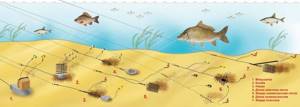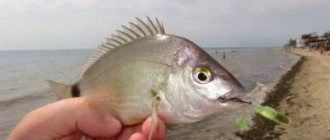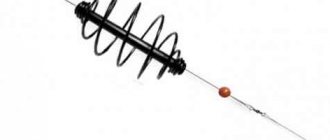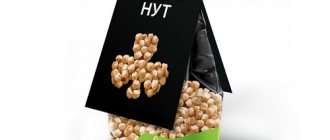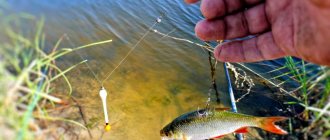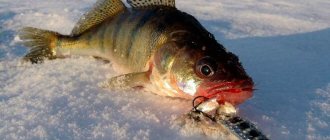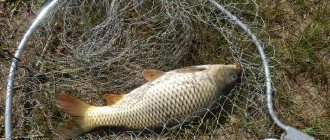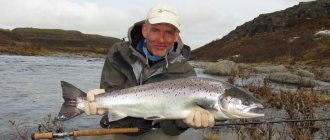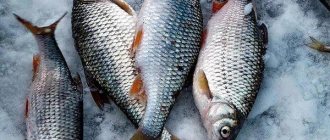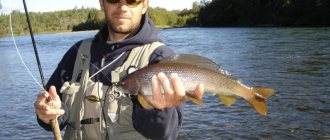Fishing with a spring has been actively practiced by anglers for a very long time, and this is not without reason, since this bottom method is very catchy.
A characteristic feature of fishing with a spring is that the groundbait (porridge) and bait on the hooks are fed to the fish at the same time (and sometimes the groundbait is also bait).
The principle of the spring: the fish begins to suck in pieces of thick bait, and soon swallows the hook with the nozzle, which is located right next to the spring with the porridge. Self-hooking of fish often occurs.
Porridge for the spring
As a rule, a variety of cereals are used as bait. Some of the most common porridges are corn and millet porridge, to which ground macadamia or ground seeds are added. The option with ground seeds is preferable.
Whatever ingredients are used, the porridge should be sufficiently viscous so that it holds well in the spring and does not disintegrate too quickly. Also, many fishermen add various smells to the porridge, for example vanilla, cinnamon and other flavorings, which are very good at attracting crucian carp.
A modern analogue of a spring is fishing with method feeders (flat). The principle of a flat feeder is the same as that of a spring; the main difference is in the design of the flat feeder itself. Read more about flat fishing by following the link.
What bait should I put in the “deadly” gear feeder?
As many people as there are on earth, there are so many opinions about what crucian carp especially prefers and at what time of year. The only thing that remains unchanged is the main part of the bait composition.
These, oddly enough, are breadcrumbs . They are a very good binding element for bait.
Crucian carp also really like sunflower cake; its smell attracts the attention of fish even in the farthest corners of the reservoir. There are a huge number of baits and their components.
, millet or pearl barley are widely used for bait Steamed wheat also attracts all the white fish.
Crucian carp is an unpretentious fish for various delicacies, but you can additionally lure it by adding a little sugar and honey to the bait. Crucian carp is a fish that loves sweets very much, and honey adds its aroma. Among the aromas, crucian carp also like anise, dill, and garlic .
You just need to be careful with the use of odors, especially in early spring and late autumn. At these times of the year, the fish are very cautious and the rich smell may not lure it, but rather scare it.
You also need to choose the right bait. If in summer vegetable baits are more popular, then in spring and autumn crucian carp prefers animals, such as dung worms, maggots and bloodworms.
Bloodworms are a great seller all year round, and if you have the opportunity to get them somewhere, don’t hesitate. This may be the only bait that works.
Spring equipment
In cases where the spring itself is equipped with a sinker, the hooks are tied directly to it. During the fishing process, and due to the weight of the same spring, self-hooking often occurs.
Leashes and hooks:
- Number of leashes - from 2 to 6;
- the length of each of them is about 5 cm;
- leashes are tied along the edges of the spring;
- leashes are made from thick braid or nylon thread.
- Use small hooks.
In other cases, springs without a sinker are used, one large or several smaller ones. With this option, a main sinker is tied to the end of the fishing line, the weight of which is selected individually, taking into account the conditions in which you will be fishing.
The average weight of an individual sinker is approximately 30-50 g.
Behind the sinker there is 1 large or 2-3 small springs, near each of which one five-centimeter leash with a hook at the end is attached.
Article on the topic: how to make bait for crucian carp
Existing Tools
There are countless options for equipment for spring fishing. Each angler uses something different: the size of the feeder, the length of the leashes, the number of hooks, the method of attaching the leash, etc., but in fact all options can be divided into two groups - with a sliding and with a blind mount.
Read more
How to catch perch on a bulldozer?
Sliding mount option
In a sliding installation, the line passes freely through the hole in the spring and is secured with a winding ring or swivel. To protect the knot from impacts from the feeder, place a rubber or plastic bead on the fishing line. The leashes are tied to the fishing line. Feeders with a sliding mount provide the gear with high sensitivity, since when biting the fish does not experience resistance from the weight of the spring, and the force is directly transmitted along the fishing line to the rod.
Blind mounting option
With a blind fastening, the spring is fixed on the fishing line motionless. The sensitivity of such equipment is less than with a sliding mount, but the fish are detected themselves due to the weight of the feeder. In blind installations, the weight of the spring should be at least 40–50 g.
Leashes
To catch crucian carp with a spring, leashes made of braided fishing line with a diameter of 0.1–0.16 mm and a length of 5–7 cm are used. Leashes made of monofilament are not suitable, since the elasticity of the line can make the crucian feel resistance and scare it away. If necessary, a thin dark-colored nylon thread can be a budget replacement for braid.

Types of spring mounting
Catching carp with a spring
To get a really good catch, it is, of course, advisable to use several bottom fishing rods at the same time.
As for the time of day for catching carp with a spring, night fishing will probably bring the best results.
It is worth adding sweet flavors (strawberry, caramel, honey, vanilla) to the bait porridge.
When fishing, do not rush to hook. As a rule, a carp bite is a series of light pokes, after which a sharp and strong jerk occurs. This is the moment you need to wait for and then quickly strike.
While fishing, try to maintain approximately a right angle between the rod and the tensioned fishing line to protect yourself from breaking the fishing rod or clutch. Having a high-quality spinning reel and a reliable clutch is a prerequisite when fishing for carp with a spring.
Catching crucian carp with a spring
There are no fundamental differences between a carp spring and a spring for crucian carp as such, but most often gear for crucian carp is characterized by smaller sizes, and therefore greater compactness.
The optimal size of the spring itself for crucian carp: height – 5 cm, diameter – 1.5-2 cm.
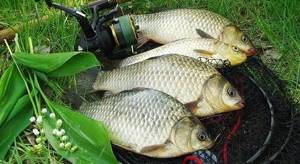
When a spring with hooks is attached between the weight and the main line, after casting, only the sinker will sink into the silt, while the spring with bait and hooks will be on the surface of the bottom soil.
This equipment is often praised by fishermen for its high sensitivity and good flight performance.
Crucian carp is well caught using millet porridge, corn porridge, or porridge made from peas and semolina. Additionally, crushed seeds, cake, various flavorings and animal food (chopped worms, maggots, bloodworms) are added to the porridge.
Spring fishing: making your own tackle, cooking the right porridge (bait)
A spring is a simple and easy-to-use tackle that can be easily bought in a store or made with your own hands, and significantly increases the chance of a good catch. But it is an unsporting way of fishing.
A more catchy analogue of a spring is a feeder tackle; it is much more sensitive and technologically advanced, allowing you to achieve a stable result time after time. We recommend a good guide to assembling the feeder here https://www.oster-vip.com.ua/news/fider-svoimi-rukami.html. For those who need spring tackle, study the current step-by-step assembly and fishing guide.
Structure of spring tackle, DIY production
The picture shows a classic spring rig with one small addition. The load here is not located inside the spring, but 5 cm from the feeder itself. This is done for two reasons:
There is more space inside the feeder for more food and to attract fish.
The feeder becomes lighter and does not sink too deeply on the muddy bottom, so the fish will easily notice such a feeder.
Just one note about this gear. Choose spring feeders with sparser distances between the wires. This will make it easier for the fish to penetrate deeper into the feeder.
The process of tying tackle is very simple
- We do not recommend making a spring yourself; fortunately, the store sells very budget feeders. To such a feeder you need to attach several leashes made of braided fishing line (braided, not monofilament - it is more elastic and will not affect the location of the hooks inside the feeder).
- Use hooks according to the size of the fish, namely the size of the fish’s mouth. The hook must fit easily into the mouth, otherwise it is too large.
- Next, we move the fishing line away from the main axis (braided or monofilament is not critical, but it is desirable that it be thicker and easily support the weight of the feeder when casting hard).
- We attach the swivel 2-3 cm from the feeder. It will not allow the tackle to twist. Will preserve the fishing line and its sensitivity.
- Next, we attach a sinker at 3-5 cm (if the sinker is not provided in the structure of the feeder itself).
It is better to use an olive with a longitudinal hole, and secure rubber stoppers at the edges (beads are less desirable, they will fray the fishing line), which will prevent the sinker from moving along the fishing line. - That's all, the equipment is ready, all that remains is to make a loop at the end of the fishing line using a figure eight knot, which, as we remember, does not move along the fishing line. It is now very easy to attach such equipment to the main line using the loop-to-loop method.
A sports version of the spring tackle, because only 1 hook is used
Spring bait
For fishing with a spring, it is advisable to use a more viscous plasticine-like bait.
The following types of ingredients work well:
- bread crumb;
- porridge: pearl barley, millet, barley;
- chopped worms mixed with soil;
- any of the ready-made specialized baits, for example from the PRO Sport series;
The most important nuance for internal bait is the consistency of medium grinding and sufficient viscosity and stickiness, because this bait must be securely fixed inside the spring and gradually “spray” in the water, attracting fish.
If you are an experienced fisherman, then you know many types of bait. But if you have just recently become interested in fishing, we advise you to try one of the easiest and fastest ways to prepare barley bait.
Homemade bait:
- 1 cup pearl barley;
- 1 glass of millet cereal;
- pour boiling water ~ 1 glass of water;
- let it brew for 20 minutes, make sure that the pearl barley swells, but does not begin to tear into pieces;
- after cooking, you can add 1 cup of cake or crushed crackers;
Baits can be divided into two categories:
- Vegetable. Canned green peas, steamed or canned corn, steamed wheat are excellent;
- Animals. It is best to use a worm, maggot, bloodworm, dragonfly larvae or mayfly butterflies.
Of course, bait should be selected depending on what kind of fish you plan to catch, taking into account its, let’s say, gastronomic preferences.
- For example, if you want to catch grass carp, you should put either the Colorado potato beetle (2-3 per hook), or its larvae, as well as the larvae of the May beetle.
- Lin loves the worm.
- Crucian carp is picky, so you need to choose bait. It may like different baits in different ponds.
- Carp classically love sweet or steamed corn.
Spring fishing technique
We recommend using a feeder rod. It is much more sensitive than a cheap spinning rod, which certainly will not give you the sensations that you can get even with a budget feeder stick.
The spring tackle can be used on a wide variety of fishing rods, including spinning rods. However, several of its features should be taken into account.
Firstly, the spring is the optimal choice for bottom fishing. Despite the fact that it can be used both in still water and during currents, its peculiarity is such that the tackle sinks to the bottom.
Then the gradual dissolution of the internal bait, tightly compacted in the spring itself, begins. Spreading in the water, the food attracts fish.
However, the decisive role here is played by more seductive baits on the hooks.
Secondly, it is necessary to remember that the spring tackle is used for catching white non-predatory fish, for example, carp. The spring fishing technique remains virtually unchanged, regardless of the type of fish chosen for fishing. It is best to throw several donks at a sufficient distance from each other - this way you will increase your “fishing efficiency”.
Don’t forget to check the donks from time to time so as not to miss bites. Do not hurry! Let the fish try the bait, wait for the moment when it reacts to the bait from the hooks - this can take a lot of time. The less you rush, the greater the chance of leaving with a great catch, because over a longer period of time the chance of a bite is higher.
Be very careful and watch for bites. If the fish has taken hold, then after a few minor bites you will not miss the moment of a strong tug. It is then that you should hook and pull out the fish, not earlier.
Correct adherence to the spring fishing technique will allow you to collect a truly excellent catch, especially since this technique is simple and does not require tricks.
Fishing with a spring is loved by fishing veterans, and is also perfect for beginners. Go for it!
We deliberately did not talk about the method of fishing with a spring without bait, since it is absolutely unsportsmanlike, less catchy and unsightly in relation to the environment.
Share your experience of fishing with a spring and a carp feeder Method in the comments. We and our readers are interested in your bait recipes and your catchy baits.
Poachers who caught 318 kg of fish were not punished
A group of fishermen revealed the name of the secret bait during interrogation.
Category: Regional news,
MORE DETAILS
Source: https://primanki.com/snasti/fider/pruzhina-dlya-rybalki.html
Spring with foam
Fishing with polystyrene foam works well in conditions where the bottom of the reservoir is covered with a layer of silt.
When the classic method of fishing with a spring does not bring results, small foam balls are used, which are placed on the hook (the tip remains open) and subsequently lift it slightly from the bottom.
It is known that both crucian carp and crucian carp often carefully try potential food first, and only then swallow it or, on the contrary, spit it out and leave it alone.
It is during such a “test” of the foam ball that the fish can be hooked.
However, she may completely ignore the foam, preferring to eat the porridge lying nearby. But even in this case, an outcome is possible in which the hook with a foam ball will be accidentally swallowed along with an abundance of bait.
Some fishermen, to give the foam a more attractive appearance, cover it with dough. You can use the same technique.
In fishing stores you can find foam balls of various sizes, colors and even smells, this allows you to choose the right size for a specific hook.
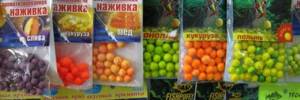
Groundbaits and bait
To prepare the bait mixture, three types of cereals are most often used - corn, peas or wheat. To add extra viscosity oatmeal is often added to it is cooked from cereals with oatmeal , after which various flavorings , which will increase the attractiveness of complementary foods for crucian carp - for example, sunflower oil, garlic, vanilla and others.
Particular attention is paid to the viscosity of the finished bait mixture - it should not disintegrate when it hits the water when casting, and also quickly wash out from the feeder lying on the bottom. In reservoirs with strong currents, it is necessary to use thicker bait.
Flavors are used depending on the preferences of crucian carp in a particular body of water at a given time. You can experiment with flavors directly while fishing, adding them to a neutral mixture and identifying the most acceptable option.
Those that arouse greater interest among crucian carp in a particular body of water as hook baits . plant-based options can be used close to the same ingredients from which the bait mixture - wheat, barley, corn, as well as animal baits - maggots, bloodworms, dung worms.
Attention! When fishing with animal baits, it is desirable that they be contained in crushed form in the bait mixture.
This will increase the chances of a bite. can also be used as a nozzle . Sometimes this fishing method causes skepticism - especially among beginners , but in practice this bait has long proven its effectiveness.
- Bait for crucian carp: comparison and recipes.
- What bait to choose for crucian carp and how to prepare it
Types of springs
Donkey springs are distinguished according to the following criteria:
- Form;
- Size;
- Presence/absence of a sinker.

Donut spring
- This is the name given to a fairly long compression spring that curls into a ring.
- The average diameter of the base of such a spring is 1-1.5 cm, while the diameter of the “donut” itself into which it can be compressed is most often around 4-5 cm.
- The leashes are not attached to the spring itself, but through a special leash. Look at the photo on the right. The shape of the spring makes it easy and convenient to fill it with porridge.
Harvester spring (cone)
- The harvester is another type of spring that is clearly recognizable by its cone-shaped shape.
- Leashes, as a rule, are attached to the top of this kind of cone.
- It’s also a fairly convenient and compact spring, which won’t be difficult to get.
Crucian carp killer:
- Three springs in series without lead.
- There is one hook on each spring.
- The length of the leashes is 5 cm.
- Braided leashes.
- Hooks 4-6 numbers.
- The distance between the leashes is 12 cm.
- At the end of the line there was a sinker weighing 20-50 grams.
Very often, fishermen hook lard or foam onto their hooks, which increases the buoyancy of the hook and makes it easier for the fish to suck it in along with the porridge.
Spring fishing technique
Having filled the spring with porridge and put bait on the hooks, we cast to the desired place in the reservoir, and then, in fact, wait for the bite.
It is highly advisable to cast the tackle in approximately the same place to ensure feeding of a specific area and attract the attention of a large number of fish.
- To throw the spring in the same place, you need to clip the line on the spool; this will not allow you to throw the fishing spot.
- The more rods you have, the higher your chances of catching more fish.
- Experiment with attachments. Try different baits right away, and then see which one bites better, use the best bait on all gear.
- You can also feed the place by hand, if the distance allows. The bait in this case should be looser than that in the spring.
Do not rush to hook, wait for an active bite and a strong jerk.
Spring fishing gear
- Rod. To successfully fish with a spring, you will need the simplest fishing rod with a length in the range of 2.1-3.5 m. This can be either a plug-in model or a telescopic one; The main thing is that the rod is long enough and strong enough. Its test starts at 40 g.
- Inertialess reel. Size 3000-4000, preferably with a bayrunner
- Fishing line. Usually they put 100 meters of fishing line with a diameter of 0.25-0.3 mm.
- Leashes are most often made from braid with a breaking load of more than 5 kg, and their length is 5-15 cm, depending on the conditions and features of the equipment.
- Hooks - numbered from 4 to 9.
- Springs can be very different.
- As a signaling device, you can use a bell or a modern electronic bite alarm.
We make the tackle ourselves from available tools and materials
To make your own tackle, you need the following materials:
- Single-core copper wire, stripped of insulation, with a cross-section of 1.5 millimeters. You can use a wire of the same cross-section made of any other stainless material.
- Empty ballpoint pen pastes or lollipop sticks.
- A weight weighing from 10 to 50 grams. The weight of the sinker is selected based on the casting distance. The farther you want to cast the bait, the heavier the weight you need to hang.
- Fishing line or monofilament for assembling tackle.
- Rubber stoppers or beaded beads . In practice, it has shown that during sharp casts, rubber stoppers tend to move, so it is better to use beads.
- Leading material . Here everyone chooses what he likes best. Many fishermen still use only fishing line.
- Swivels with carabiners.
- Hooks.
Instructions for assembling the tackle with your own hands:
- Cut a 40-centimeter piece of fishing line or monofilament with a thickness of 0.25–0.5 millimeters.
- We tie a swivel to one edge. It is up to you to choose which knot to use when tying the fishing line to the swivel, but the knot must be strong.
- Open the carabiner and attach the weight to it. If you don’t have a sinker with an eye at hand, you can use a sliding one. To do this, instead of a swivel, we tie a weight to a fishing line.
- You insert the bead onto the fishing line, not bringing it 100 millimeters up to the sinker . Secure it by inserting a line through it. You make three turns, which makes the bead immovable.
- You insert another bead. Bring her to the first. There is no need to attach it. It should rotate freely around the line. If you use a lineless tackle, then instead of a bead, thread a swivel with a carabiner. It will perform the same function.
- Thread another bead and, as in the first case, make three turns of the fishing line around it. The distance between the first and third beads should be no more than 3 millimeters.
- Cut the empty paste from ballpoint pens or lollipop sticks into 40 millimeters long. Insert the copper wire into the resulting tube and heat it with gas or a match. After a little heating, the plastic softens. Press the wire against the seaming lid or any metal object and lower a piece of paste or stick a little. You will get a fungus, on the one hand.
On a felt-tip pen or pencil one centimeter thick wind seven turns of wire and bite off the rest with pliers or wire cutters. Make small ears on both sides using pliers. Place the ears in the middle of the coil diameter.
- Insert the prepared paste tube into the resulting spring. On the other side, perform the same operation so that the spring does not fall off the paste. Place all the coils of the resulting spring at the same distance. You need to make three such springs.
- Thread the spring, bring it to the beads and fix it on the other side. To fix the spring, you also use a bead.
- If you use leashes, tie the hooks and attach them to a bead that moves freely.
This operation must be performed with three springs. The distance between the springs should be no more than 10 centimeters.
Fishing with a spring in the current
Fishing with a spring becomes more difficult in conditions where there is a clearly noticeable current.
Then the spring is carried away from the desired place to another, and sometimes it can even be dragged along the bottom for a long time until some obstacle is encountered along the way.
To prevent such problems from arising, weighted springs are used.
It is also worth making sure that the bait is even thicker than usual when fishing in calm water.
